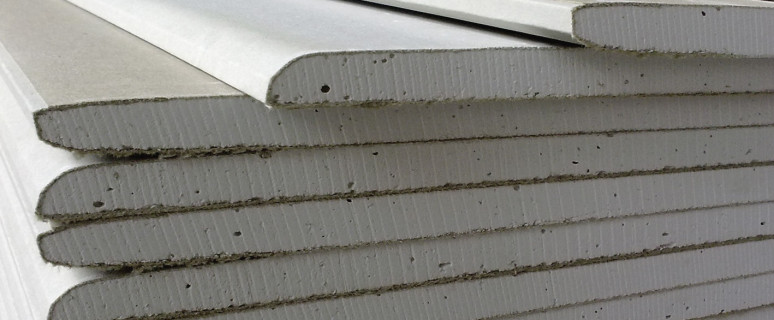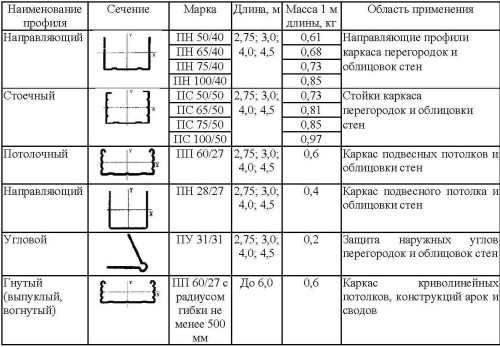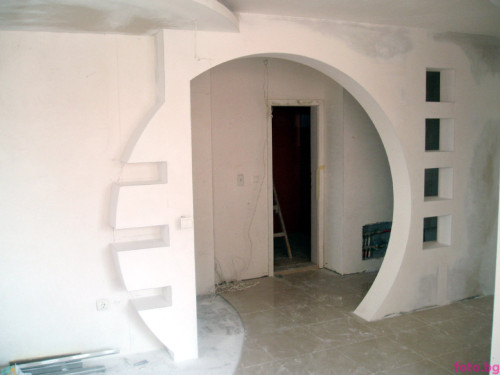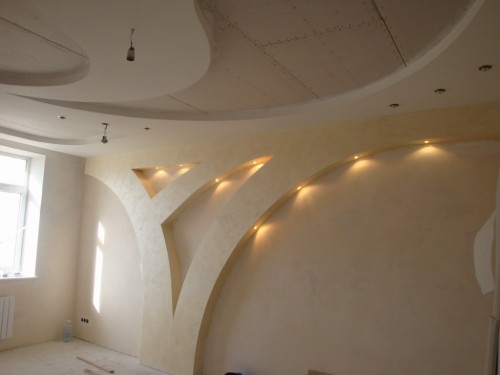
What plasterboard is better: for walls, ceiling, partitions Building materials

Today you can already boldly assert that there is plasterboard in each house. As a decent alternative to plaster, the workers remain only to install sheets on the wooden frame, fill the joints, sand and paint. What are the types of plasterboard and where it is better to apply them, we will tell in our article.
Content
Features of drywall. Characteristics and operation
Gypsum - natural mineral. It was mined since ancient times for the manufacture of plaster plaster. Its traces were found even in Egyptian pyramids. At the end of the 19th century, a plaster board was patented, the so-called "plaster plate", however, she received his spread during the construction boom at the end of World War II. This quick and inexpensive way of erection of partitions, alignment of walls, creating tail ceilings, niches and arched outlooks, quickly took the leading position in the repair.
As you know, plasterboard goes on sale in the form of rectangular flat sheets. The technology of its production is simple: the purified and crushed mountain breed is evaporated, mixed with chemicals and minerals, and through catalysis causes the gypsum faster. The mass is evenly poured between the layers of cardboard, like a sandwic area, and is molded from the ends. In the drying unit of the panel are exposed to high temperatures, after which they are cooled and package. One of the advantages of the drywall is that it is plastic in a wet state, and when drying it takes stepping. This quality is indispensable when creating curvilinear structures.
Depending on the type of material, the size of sheets differ. Through the thickness of the plasterboard there are three species: 6 mm, 9.5 mm, 12.5 mm. Some manufacturers can reach 24 mm, but it is rare.
The width is from 600 to 1200 mm, and the length of the sheets reach from 2500 to 4000 mm.
Slim drywall is used to create curvilinear surfaces, arches.
The technologies for the manufacture of plasterboard form five main types:
- GLK (Plasterboard sheet) - standard material. Universal plasterboard can be applied in rooms with humidity no more than 60%. It is often a gray-brown shade with labeling in blue.
- G CLEB (plasterboard sheet, moisture resistant). Used in rooms where humidity indicator is more than 60%. In production, the antifungal composition is mixed into the liquid mass, as well as additives that reduce moisture absorption, and the facing of cardboard is made moisture resistant and impregnated with an antiseptic. However, even this material implies additional measures, such as moisture-resistant finishing. Recognize such plasterboard is easy: it is green and labeled blue.
- GKLO (Plasterboard Fire-Resistant). As additives in it, refractory mineral fibers are contained and such material can be used to achieve a fire fighting effect, for example, in industrial or public institutions. GKLO withstands up to 20 minutes of direct impact of flame and labeled in red.
- Glevo is a special type of drywall, which included the properties of the G Clac and GKLO. Moisture-resistant material with high refractory, in turn, green with red marking.
- GKLU (Hypzonton List enhanced) is a type of heavy-duty material, which is characterized by sound insulation qualities and increased damage resistance.
In addition, these types differ by type of edge:
- direct (PC) is used in dry installation and does not require the processing of joints; It is intended for a multi-layer cladding as an inner layer;
- the drowning (CC) is used in conjunction with the reinforcing ribbon and putty;
- rounded (ZK), requires putty, but without reinforcement;
- the semicircular from the front side (PLC) is applied similarly to the rounded;
- the semicircular and thinned from the front side (Pluk), needs a putty and imposing reinforcing tape.
Most often, the plates of the Criminal Code and Pluk are used, since after processing their seams there is no protrusions.
But this is not all about the varieties of material. Production technology does not stand still, and before selecting drywall, familiarize yourself with the so-called "special" species designed for specific use.
Arched plasterboard serves to embody forms of any complexity and curvilinence. Its thickness is 6.5 mm, the gypsum core is reinforced by fiberglass, and the cardboard used is higher. This gives a sheet with the opportunity to take a rounded form without cracking. It is used to trim the arches, screw stairs, dome-shaped ceilings, simpleness with a small radius of rounding, wave-like stepped ceilings.
Acoustic drywall is sheets with perforation with a diameter of about 1 cm and a glovenic nonwoven spandback type, on the reverse side. It is intended for finishing the premises with increased requirements for soundproofing and eliminating echo, such as recording studios, rehearsal bases, concert halls, cinemas, technical premises. It is impossible to put it, but you can paint. Effective noise absorption is achieved even at low frequencies due to the reduction in the intensity of the reflected sound wave from the perforated surface. Plates are used, including on curved surfaces, allowing you to embody any intentions of architects.
Laminated drywall is panels, in industrial conditions covered with tissue-paper decorative lamination. Thus, in a single coating, manufacturers combine all the quality of gypsum with a variety of laminate shades, among which imitation of natural wood, fabric, stone. Eco-friendly and safe, material is mounted on an aluminum profile with the help of bilateral construction scotch.
The advantages of such a coating are in ease of installation, easy care and spectacular appearance. Laminated GLC is an already ready finishing finish of the room, and this significantly reduces costs and time on plaster, grinding, wallpaper or paint. The film is resistant to wear, fading and easy to clean.
Plasterboard: What better and what to pay attention to
- Remember that poor-quality material looks good only on the shop window. In fact, even the usual delivery to the house can become a problem. If the core is too fragile, the sheet is very quickly destroyed during transportation and transfer. Rule number 1: In no case, the cardboard should not be flawed from the gypsum.
- We pay attention to the sheet thickness. For the reliable design of thickness in 9mm is not enough. Rule number 2: The ideal thickness of the plasterboard for walls and ceilings is 12.5 mm.
- We look at the color of the cardboard surface. As previously written, the green speaks of moisture-proof impregnation using silicone. Such material is best suitable for the bathroom and kitchen. Sheets with pink labeling, and therefore refractory, stand much more expensive, but in many properties are equal to ordinary GLC. The fact is that the composition of the crystal lattice of the gypsum is such that it contains water, which, when heated, departs from the crystal structure and is released in free form, thus reducing the temperature of the material itself.
- The next question - how much should the stove weigh? The smaller the better, since this indicates the absence of unnecessary impurities and additives into the core.
- Few people know that the pH level (hydrogen indicator) of drywall is very close to human, which means that with direct contact it does not cause allergies and can be used even in children's rooms.
What is the plasterboard to choose?
An unambiguous answer is the question of which plasterboard is better to choose for the ceiling no, as there is no and some special ceiling drywall. This concept is conditional, because largely depends on the circumstances and features of the structure. It is believed that the thinner of the slab, the more easier and, therefore, is easier to mount them. In addition, it facilitates the suspension system. This, of course, is so, but a sheet of a thickness of 9 mm is not so easy to fasten it to be smooth, and reliability in such a coating is lame, while 12.5 cm will ensure the rigidity and smoothness of the ceiling.
It must be said that the manufacturers themselves often contradict themselves in the instructions, where they call 9-millimeter plates then ceiling, then purely structural. Under the structural thickness, the one that falls on bends is leaning the deformation and is processed by water for softening. If the bend radius is not too small, then you can do without arched drywall, using a sheet of a conventional thickness of 9.5 mm. And the remaining planes of the ceiling is recommended to still sew the moisture-resistant GLCs of 12.5 mm.
The optimal thickness for sewing walls with residential rooms is 12.5 mm, if the type of room and its operation does not provide for greater thickness. Choose which plasterboard is better suitable for walls, it is easy to focus only on the level of humidity. If it is a kitchen or bathroom, the waterproof material is taken, if not, then - the usual one.
Tip: In order for the plasterboard to serve you as long as possible, install it not on wooden bars, but on a metal frame.






















